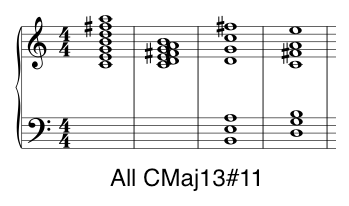Introduction
In this module we learned a number of widely used Jazz Chord Voicings. But, of course, these voicings are not exhaustive. There are scores of voicings for every chord type because, after all, a voicing is just a way of combining the notes of a chord into different intervals. So it’s worth discussing some General Chord Voicing Rules so that you can create your own Jazz chord voicings.
When playing a chord, there are really two things you need to take account of:
- The Chord Itself – notes that make up the chord; and
- The Chord Voicing – the order of and interval between the notes.
The Chord Itself
- You must play the Guide Tones (3rd & 7th)
- You do NOT have to play the root or 5th
- You can add available tensions (9th, 11th, 13th)
So you can play a CMaj7, CMaj9, CMaj9#11, CMaj13, or CMaj13#11 (again, using only available tensions).
- For example, a CMaj13 can be voiced: E B D A.
The more extended and altered the chord is, the more tension you will create with that chord. We can call this the ‘harmonic tension‘.
The Chord Voicing
The voicing of a chord relates to the intervals between the notes. You can alter the tension of the chord by altering the voicing of the chord, even if you’re playing the same notes.
- Voicing a chord with consonant intervals will give you a consonant sounding chord
- Voicing a chord with dissonant intervals will give you a dissonant sounding chord
| Perfect Consonance | Imperfect Consonance | Dissonance |
|---|---|---|
| Perfect Unison | Minor 3rd | Minor 2nd |
| Perfect Octave | Major 3rd | Major 2nd |
| Perfect 5th | Minor 6th | Minor 7th |
| Perfect 4th | Major 6th | Major 7th |
| Tritone | ||
| Minor 9th (8av + semitone) |
So, for example, let’s take the chord CMaj13#11. Now we could voice it in the following ways:
- Consonant Voicing – Tertian Harmony (stacked 3rds)
- CMaj13#11 = C E G B D F# A
- Notice there are NO dissonant (semitone, tritone, etc) intervals between any of these notes
- Dissonant Voicing – Secundal Harmony (Tone Clusters)
- CMaj13#11 = C D E F# G A B
- Notice there are MANY dissonant intervals (semitones, tritones, etc.) between all the notes
- Quartal Harmony
- CMaj13#11 = B E A D G C F#
- Notice there are many consonant intervals (perfect 4ths) but one dissonant interval (tritone between the C and F#)
- Other Voicing
- CMaj13#11 = D G B C F# A E
- Notice there are some consonant intervals (perfect 4ths, Major 3rds) but also some dissonant interval (semitone between the B and the C; tritone between the C and F#)
The more dissonant intervals the chord voicing has, the more tension you will create with that voicing. We can call this the ‘voicing tension‘.

Combining Consonant and Dissonant Intervals creates more interesting sounding voicings.
Generic Chord Voicing Rules
As well as the above, below are some Generic Chord Voicing Rules.
- Avoid using too many 3rds (this is too boring)
- Using 4ths and tritones creates a more ‘open’ and ‘harmonically ambiguous’ sound
- Use wider intervals at the bottom (to avoid muddiness)
- Play dissonant intervals in the middle
- Play a consonant interval like a 3rd or 4th between the two highest notes
- Avoid ‘doubling’ notes within the chords, except the top note which can be doubled (otherwise the chord sounds lopsided)
- Keep all intervals smaller than a Perfect 5th, except the interval between the two bottom notes that can be wider (this ensures what you’re playing sounds like a single whole chord rather than two chords played simultaneously but far apart from each other)
Harmonic vs Voicing Tension
By altering the chord and the voicing you can create and resolve tension while playing a chord progression. And let’s differentiate between:
- Harmonic tension = Tension that results from the type of chord you are playing (Maj, min, V7, etc.) and any extensions and alterations to that chord.
- Voicing Tension = Tension that results from the voicing or intervals between notes.
(Aside: as well as the above, you also need to take note of the voice leading from chord to chord, but we will leave this for another lesson)
For example, let’s take a II-V-I in C:
- Dm7 = Low Tension
- G7 = High Tension
- CMaj7 = Low Tension
| Basic Chords | Dm7 | G7 | CMaj7 |
|---|---|---|---|
| High Tension with NO Resolution | |||
| Chords | Dm13 | G13#9 | CMaj7#11 |
| Notes | D-F-B-C | E-F-A#-B | E-F#-B-C |
| Harmonic Tension | Low | High | Low |
| Voicing Tension | High | High | High |
| High Tension WITH Resolution | |||
| Chords | Dm13 | G13#9 | C6 |
| Notes | D-F-B-C | E-F-A#-B | E-G-A-C |
| Harmonic Tension | Low | High | Low |
| Voicing Tension | High | High | Low |
Conclusion
So when ‘comping or playing a chord progression, do take account of:
- The Chord itself – notes that make up the chord;
- The Chord voicing – the order of and interval between notes;
- The above Chord Voicing Rules; and
- Voice leading – transition between chords.
And adjust the level of tension as required and desired.
Video #1
Video #2